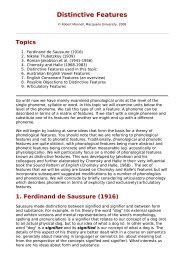The Syllable and the Foot : Summary - Speech Resource Pages
The Syllable and the Foot : Summary - Speech Resource Pages
The Syllable and the Foot : Summary - Speech Resource Pages
Create successful ePaper yourself
Turn your PDF publications into a flip-book with our unique Google optimized e-Paper software.
<strong>The</strong> <strong>Syllable</strong> <strong>and</strong> Phonotactic<br />
Constraints<br />
Jonathan Harrington <strong>and</strong> Felicity Cox<br />
Phonotactic Constraints<br />
We have seen in <strong>the</strong> preceding section that all languages build <strong>the</strong>ir<br />
words from a finite set of phonemic units. It is also true that in all<br />
languages <strong>the</strong>re are constraints on <strong>the</strong> way in which <strong>the</strong>se<br />
phonemes can be arranged to form syllables. <strong>The</strong>se constraints are<br />
sometimes known as phonotactic or phoneme sequence constraints<br />
<strong>and</strong> <strong>the</strong>y severely limit <strong>the</strong> number of syllables that would be<br />
<strong>the</strong>oretically possible if phonemes could be combined in an<br />
unconstrained way. Some simple examples of phonotactic<br />
constraints in English include: all three-consonant clusters at <strong>the</strong><br />
beginning of a word start with /s/ ('sprint', 'squire', 'stew' etc);<br />
nasal consonants cannot occur as <strong>the</strong> second consonant in wordinitial<br />
consonant clusters unless <strong>the</strong> first consonant is /s/ (e.g.<br />
<strong>the</strong>re are no words in English than begin with /bm dn/ etc),<br />
although this is certainly possible in o<strong>the</strong>r languages (e.g. German<br />
which allows /kn/ in words like 'Knoten', meaning 'knot' - we can<br />
see from <strong>the</strong> spelling that English used to allow this sequence as<br />
well). Ano<strong>the</strong>r important point about phonotactic constraints is that<br />
<strong>the</strong>y vary from language to language, as this example of English<br />
<strong>and</strong> German has just shown.<br />
We will consider firstly why languages have phonotactic constraints.<br />
<strong>The</strong> main reason is to do with <strong>the</strong> limits on <strong>the</strong> talker's ability to<br />
pronounce sequences of sounds as one syllable, <strong>and</strong> <strong>the</strong> listener's<br />
perception of how many syllables he or she hears from a given<br />
sequence of phonemes. Consider for example a sequence like /pʁ/<br />
i.e. a voiceless bilabial followed by a voiced uvular fricative. Most of<br />
us with some training can produce this sequence (e.g. /pʁa pʁit/<br />
etc.) as a monosyllabic word even though it doesn't occur in<br />
English. Now try reversing <strong>the</strong> order of <strong>the</strong> cluster. With some<br />
phonetics training, you could almost certainly produce /ʁp/, but<br />
what is much harder (even for a trained phonetician) is to produce<br />
<strong>the</strong> sequence before a vowel such that <strong>the</strong> resulting sequence is<br />
monosyllabic. For example, try /ʁpi/ -- even your best attempts at<br />
producing <strong>the</strong> /ʁ/ followed by <strong>the</strong> /p/ will probably still lead to a<br />
percept of two syllables when /ʁp/ precedes a vowel.
















